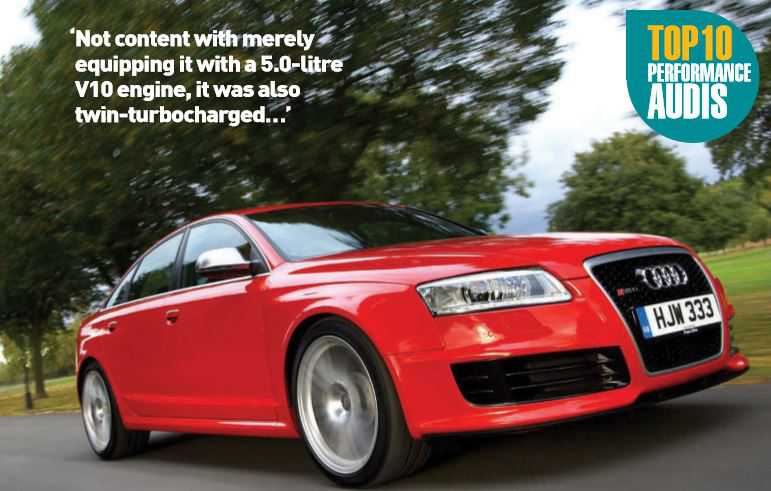Top 10 Performance AUDIs: 8) C6 RS 6 (2008-2010)

With the high-performance RS 2 and RS 4 models, Audi had clearly set itself an agenda to develop an ever more powerful range of super Saloons and Avants. After successfully producing a twin-turbo 4.2 V8-powered RS 6 version of the c5 S6, the bar was set even higher for the sixth generation model that was introduced at the moscow Show in late 2007. not content with merely equipping it with a 5.0-litre V10 engine, it was also twin-turbocharged… The non-turbo version in the S6 had been potent enough, with 435 PS and 540 Nm, but forced induction for the 5.0 V10 in the RS 6 pushed this up to 580 PS at 6250 rpm and produced a tremendous torque figure of 650 Nm all the way from 1500 to 6250 rpm. The only transmission capable of reliably transmitting that sort of power and torque was a 6-speed ZF automatic with Tiptronic shift, its gear ratios carefully matched to the characteristics of the engine. Initially introduced as an Avant, the bi-turbo V10 produced a 0-100 kph (0-62 mph) time of 4.6 seconds, with 220 kph (125 mph) coming up in 14.9 seconds. The top speed was limited electronically to 155 mph, with a factory option to de-restrict the top speed to 170 mph. The Saloon version that followed a few months afterwards was slightly faster, stopping the clock at 4.5 seconds for the 0-62 mph time. Even more impressive were the 30-50 and 50-70 mph times, just 2.0 and 2.6 seconds respectively, although there was a price to pay for all this performance, with an overall average of 17-18 mpg and even economical driving could barely achieve 25 mpg, giving a fairly limited range from the 17.6-gallon fuel tank. Other special features of the C6 RS 6 were that it had aluminium front wings and bonnet, flared front and rear wheel arches and large frontal air intakes for the two side-mounted intercoolers and extra radiators. LED daytime running lights were incorporated into the main headlamp housings that provided adaptive headlights which swivelled on cornering.
Dynamically, the C6 RS 6 used the latest version of the Torsen fourwheel drive system that had been used on the B7 RS 4, with a basic 40:60 rear bias, but capable of adjusting to a maximum of 100 per cent to the rear or 80 per cent to the front wheels, as required. Additional traction requirements were catered for by the EDL and ASR electronic functions in the Electronic Stability Control (ESC) system. Like the previous RS 6 and the B7 RS 4, the C6 RS 6 had Dynamic Ride Control (DRC) adaptive damping and Servotronic speed-dependent power steering. With 390 mm discs and 6-pot callipers at the front and 356 mm discs at the rear, with 420 mm Ceramic discs also available as an option. Along with the standard 9.5J x 20-inch alloy wheels running 275/35 ZR 20 tyres, the C6 RS 6 also had the handling and braking ability to harness its prodigious performance. We concluded our road test of the C6 RS 6 Avant in September 2008 with the words ‘No other car in the world can offer this blend of performance, roadholding, traction and practicality!’
